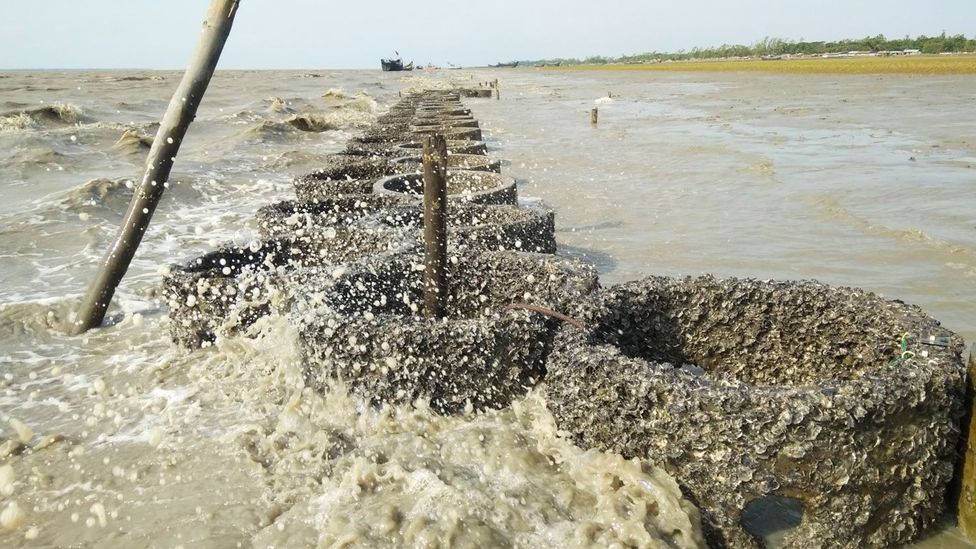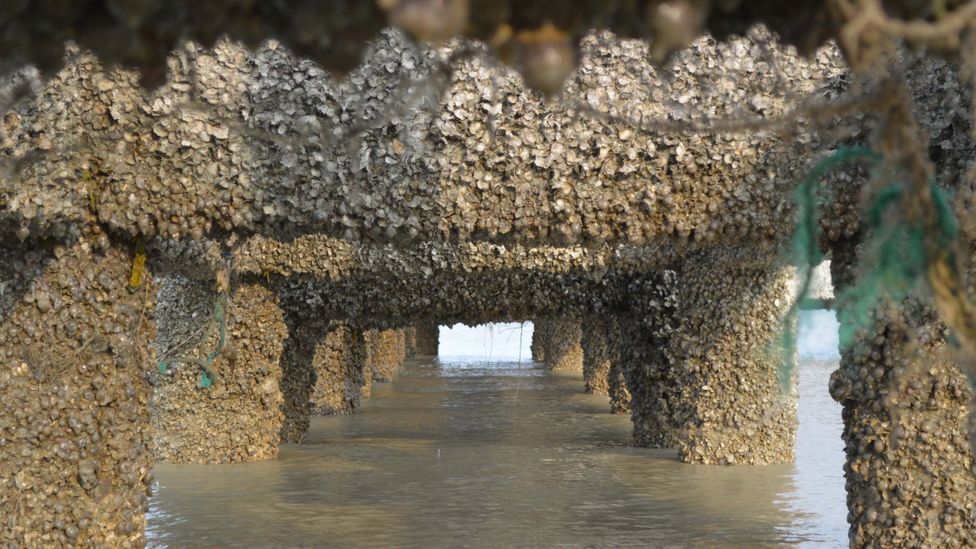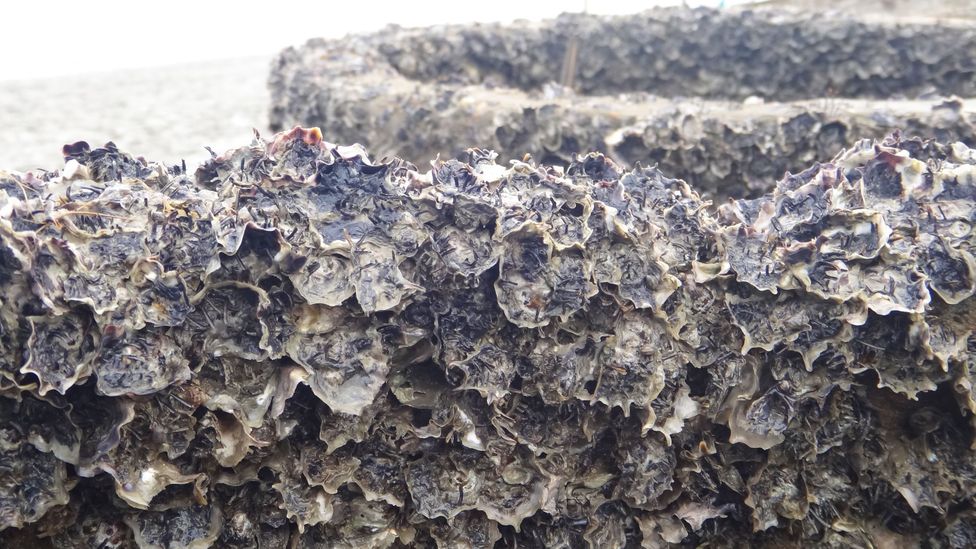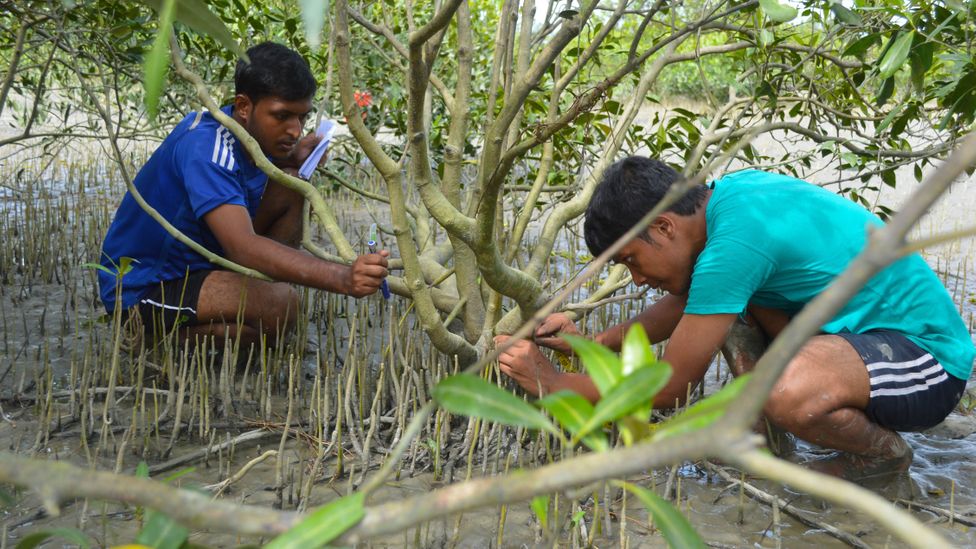
Article continues below
Nothing could have prepared Mohammed Shah Nawaz Chowdhury for the sobering reality of Kutubdia Island. The island, off the coast of southern Bangladesh, was rapidly eroding into the sea, causing both land and life to retreat. Many packed up and moved. Those who couldn't, stayed – inching back, as the island they had called home for generations changed around them. "These were families I had gotten to know, trust and respect," he says. "It regularly moved me to tears."
Chowdhury was witnessing Bangladesh's climate migration, caused by sea level rise linked to climate change. By 2050, up to 13.3 million Bangladeshis may become displaced due to climate change.
Yet, just off Kutubdia Island's shore, a glimmer of hope is visible amid the waves. Jutting out of the water, oyster-encrusted reefs glisten in the sun. These reefs are vibrant homes for marine life, a potential source of income for local people and, Chowdhury hopes, they could become a formidable force to defend Kutubdia Island from sea level rise.
Kutubdia Island, with its fast receding shoreline, is a microcosm of these challenges at their fiercest
The idea of Kutubdia Island's oyster reefs was born in 2012, when Chowdhury was a research associate at the Institute of Marine Sciences, at the University of Chittagong, in Bangladesh. The premise was simple: oyster reefs could serve as a defence mechanism against coastal erosion by calming waves before they reached the shore. The idea had worked before in the Netherlands, and had also had success in Louisiana in the US. Now, researchers at Wageningen University would work together with Chowdhury and his colleagues to see if they could improve the situation at Kutubdia Island.
The catch, of course, was that Bangladesh and the Netherlands, and indeed Louisiana, are thousands of miles apart and have wildly different environmental contexts. "We were facing a lot of challenges like natural sedimentation due to river run-off, storm surges and other monsoonal effects that make our coast so dynamic," says Chowdhury, "I wasn't sceptical, but we had to plan. A lot."
It was a tantalising prospect. Could ecological engineering through oysters save the dynamic coastline of Chowdhury's homeland? He spent the next six years, including more than 600 days with 27 students living on Kutubdia Island, finding out.

Many of the residents of Kutubdia Island have had to move from their homes as the island has been engulfed by the sea (Credit: Getty Images)
Regularly pelted by storms, cyclones and sea level rise, Bangladesh's coast is susceptible to many climate stresses. Kutubdia Island, with its fast receding shoreline, is a microcosm of these challenges at their fiercest. "Potentially, it has been estimated that by 2050, one in every seven Bangladeshis will be displaced by climate change," says Chowdhury. "We're getting more ferocious waves due to global warming and heating waters."
Traditional structural interventions, such as concrete embankments or dykes, have been a common response to protect the shoreline. According to Rezaul Karim Chowdhury, executive director of the Bangladeshi NGO Coast, 60% of the country's coast is protected by embankments. But some argue that building a living defence, rather than one made of concrete, could be more effective.
Oyster breakwaters
Ecological engineering, or eco-engineering, involves designing sustainable ecosystems with both natural and human value. Oysters engineer their environment by clustering on hard, submerged surfaces and fusing together to create reef structures. Their role in filtering and retaining nutrients in water, providing spawning and shelter for fish, and so boosting biodiversity is well-documented. Oyster reefs provide a habitat for other animals, improve water quality and enhance seagrass growth.
But Mohammed Shah Nawaz Chowdhury and his colleagues in the Netherlands were particularly interested in their role as natural breakwaters. Oyster reefs can provide relief to a coast constantly buffeted by strong waves. That is not their only benefit, though. "What you want is the sedimentation behind the reef structure that the oysters naturally form. The reefs give you a more extensive foreshore and [consequently] calmer waters," says Petra Dankers, senior consultant for morphology and eco-engineering at Royal HaskoningDHV, which partnered with Wageningen University, in the Netherlands, on the Kutubdia Island project.
Such fluidity is the hallmark of the building with nature approach. And rather than being seen as a setback, it becomes part of the plan.
"It's a dynamic process – not hard concrete. And that's the new understanding of using natural forces to achieve our goals," says Aad Smaal, emeritus professor of sustainable shellfish culture at Wageningen University.

The artificial reefs provided a home for many other species besides oysters (Credit: M. Shah Nawaz Chowdhury)
The natural forces shaping Kutubdia were especially important to understand because, unlike many oyster reef projects across the world (for example, in the Gulf of Mexico), this was not a restoration of a declining reef. It was an introduction of new reefs as engineering structures.
Fortunately, the region presented many of the ideal conditions necessary for the reef, Chowdhury found in his initial survey. There was the appropriate water temperature, water flow velocity, pH levels, salinity and dissolved oxygen. The marks of life already existing in the water, such as phytoplankton, also indicated that this could be a place where oysters would thrive.
Next, they needed to check if oyster larvae were already present in the Bay of Bengal waters. "It's not just a case of putting something in the water and expecting it to work," says Smaal. One of the best substrates (surfaces on which organisms like molluscs grow), he says, is existing oyster shells. "It's also about successful recruitment, meaning the passively drifting larvae will settle and not move anymore," he adds. "Even in an open system with strong currents."
In fact, Kutubdia Island showed large clusters of oysters growing naturally on concrete pillars, especially near a jetty. And as studies suggest, concrete is one of the most successful alternative substrates after natural oyster shells – with reefs on concrete equalling or in some cases surpassing the size, biomass and density of oysters.

Oysters grew spontaneously on concrete pillars near a jetty at Kutubdia Island, giving the researchers hope that they would colonise the new reef (Credit: M. Shah Nawaz Chowdhury)
So, to start the new reef, Chowdhury and his team chose more concrete. "We wanted to use what was locally available and sustainably priced," he says. The structure of choice? Circular rings that the local residents stack and top with a commode to create latrines. These would not only be readily available, but could withstand the rough weather during the monsoon.
Insider knowledge
But while oysters might grow abundantly on concrete in some situations, they are highly particular about other features of their habitat.
"The oyster... it has a specific preference for growing conditions," says Chowdhury. "They can't be exposed to air or sun for over 20% of the time."
The best people to help find the right spot for the artificial reef were the indigenous coastal community, Chowdhury says, who were already attuned with the rhythms of the rise and fall of the tide across seasons. The local islanders' knowledge of the kostura (the local word among islanders for oysters) proved invaluable for him and his research associates before the first 300kg (661lbs) rings went into the water at a test site in 2014. Local people also helped select the best sites for the concrete rings to be placed two years later when they were moved to their final destination in 2016. "I always respect indigenous knowledge," says Chowdhury.
Once in the right place with the right conditions, the reef would be able to grow upwards and keep pace with sea-level rise. Minor damage to the reef, especially by natural causes, would be self-repaired – the new population grows again to fill the space and account for any oysters lost.
The researchers hoped that the oysters could also become a nutritious source of food and rich harvesting opportunities for the local community. Though this went somewhat against the grain of local tastes. "Though oysters are technically halal [lawful in Islam], there isn't much of a consumption habit in Bangladesh so far," says Smaal.
"Not all of our people are interested in oysters," Chowdhury agrees, noting that they aren't widely eaten in Bangladesh. "Some don't even know what the oyster is."

Over time, the oysters clustered thickly on the concrete rings to form a rich reef (Credit: M. Shah Nawaz Chowdhury)
But while they didn't consume the oysters directly, the experienced Kutubdia fishermen were well aware of the fertile habitat and plentiful fishing grounds that oyster reefs provide.
"We started finding mud crabs in the rings, drawn by the reef," says Chowdhury. "Mud crabs have immense export value. 1kg can be sold for $10 [£7.30]. Two to three families can easily make a livelihood off a small oyster reef by adding traps," Chowdhury says. Other species the research team found included barnacles, sea anemones, gastropods and polychaetes (marine worms) – all of which can attract fish.
Osman Ali, a 55-year-old fisherman who has spent his life on the island, says after the reefs began to grow, he no longer needed to work such strenuous hours to make a living. "We find a higher abundance of fish, shrimp and crabs near the kostura," he says. And while the reef spanned only 100m (328ft), Ali is convinced: "If a larger reef had been created, it would increase our likelihood of getting more fish."
"I proposed a partnership with the fishermen," says Chowdhury. "If you take care of the reef, it will take care of you."
Ripple effects
While the fish were welcome, it was the accumulation of sediment behind the reef that began to make a difference.
"Depending on the environment you're in, sedimentation gradually accumulates on the lee side," Dankers says. "In the Netherlands, we saw 1-5cm (0.3-2 inches) a year. In Bangladesh we saw up to 30cm (12 inches)," she says. The massive amounts of Himalayan silt in the coastal deltas was the reason for such a marked difference.
"We talk about resources, but we ignore the sediment in our water," says Chowdhury. "Billions of tonnes of sediment are flowing through our extensive Bhramaputra, Meghna and Ganges river network. If we could find a way to settle it in our coastline, we could make a new country."
The reef helped sediment to accumulate for as far as 30m (98ft) behind it, Chowdhury found, and stabilised the silt even during the monsoon season. The reef completely dissipated waves lower than 50cm (20 inches), and those over 1m (40 inches) also had their force considerably reduced. It worked even in intense weather – observed when tropical cyclone Roanu, with wind speeds of 70-110kph (43-68mph), hit the study site in May 2016. The vegetation nearby flourished too compared with the control locations.
This vegetation could be crucial in helping restore the coast, as it does in other parts of the country. "Near the Sundarbans area [in the south-west], you don't see erosion [because] mangrove forests act as a bioshield,” says Chowdhury.
This chimes with research by Susmita Dasgupta, an environmental economist at the World Bank. Mangroves are an effective way to protect against storm surges, she writes. The mangroves obstruct the flow of water with roots, trunks and leaves, reducing water flow velocity by 29-92%.
"You could have the oyster reef first, and behind that, the mangrove," says Dankers. Many of the world's coasts used to have a fringe of mangrove forest, she says, but much has been lost in the past century. "Depending on how extensive your mangrove system is – for instance, it might span a few kilometres – you may or may not need a dyke or wall as well."

Oysters are only the first line of defence – they can also help encourage the growth of mangroves behind them as further protection (Credit: M. Shah Nawaz Chowdhury)
But oysters can only help to a certain extent. Dankers cautions that there is a looming, unaddressed concern posing an imminent threat to low-lying coastal countries like Bangladesh: rapidly sinking soil. In Bangladesh it is sinking at rates of 5-20cm (2-8 inches) a year, Dankers estimates, making the fight against sea level rise harder, and is expected to worsen as development (and populations) increase.
Recent studies find that the greatest causes of subsidence are often human-induced – including groundwater withdrawal, oil and gas extraction, and mining. And the problem is only compounded in densely populated areas and coastal cities with local, upstream flood defences which limit sediment supply.
"Groundwater extraction is a big issue at many locations worldwide and where it isn't yet, it will become one if no proper legislation is organised," says Dankers. "For Bangladesh, it is now the time to come up with legislation so it will not end up like Jakarta, the capital that is flooding every high tide... We can work with sedimentation on the coast, but the bigger problem is soil subsiding.
"You can't keep building higher and higher up with rigid structures. There comes a point when you can't keep up. And such [natural] solutions take time. You want to get the reefs started early."
Today, the oyster reef at Kutubdia Island seems to have held up the "natural" part of the building with nature bargain, but the necessary upkeep by humans has been somewhat neglected. The reef has grown, but a few portions have been broken down by boats at high tide. "The site has lost the sign pole we put up to avoid this," says Chowdhury. "We don't have the funds to put it back and monitor further." He hopes to establish a larger testing site of at least a kilometre in length to show the reef's potential.
Nevertheless, Smaal is hopeful. "We're aware of the vulnerabilities of living reefs, such as susceptibility to disease. Yet oysters are robust." He hopes oysters will be part of a paradigm-shift in the way we view coastal defences. "The idea is to use natural resources and build with nature," he says. "Because working against it just isn't feasible anymore."
--
The emissions from travel it took to report this story were 0kg CO2. The digital emissions from this story are an estimated 1.2g to 3.6g CO2 per page view. Find out more about how we calculated this figure here.
--
Join one million Future fans by liking us on Facebook, or follow us on Twitter or Instagram.
If you liked this story, sign up for the weekly bbc.com features newsletter, called "The Essential List". A handpicked selection of stories from BBC Future, Culture, Worklife, and Travel, delivered to your inbox every Friday.
No comments:
Post a Comment